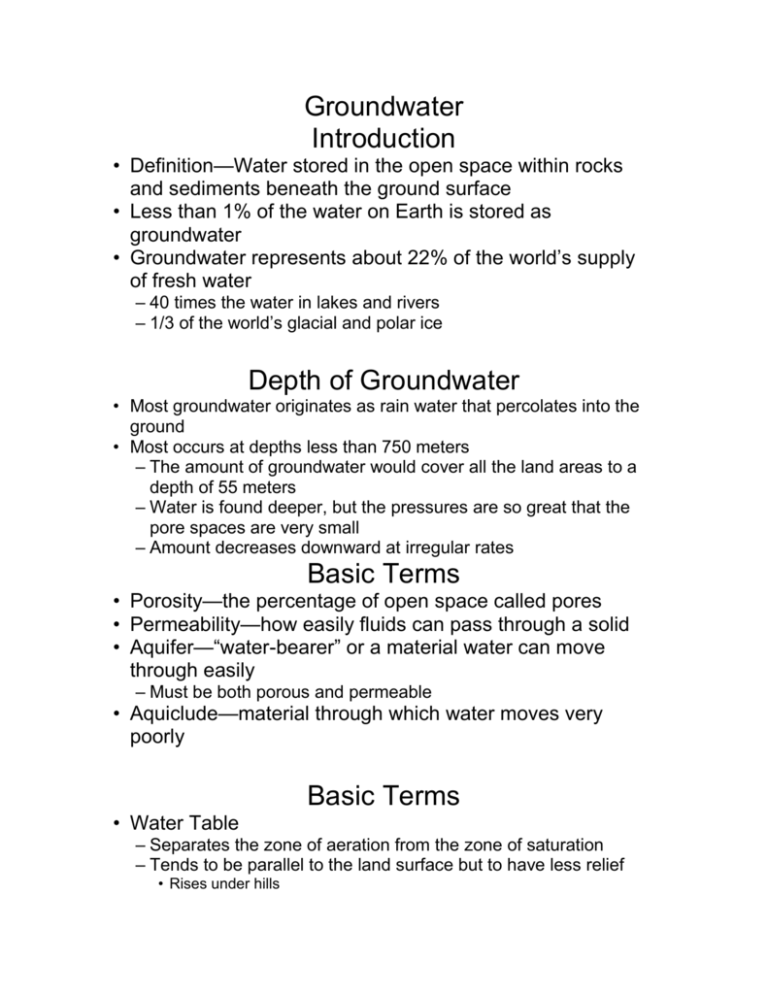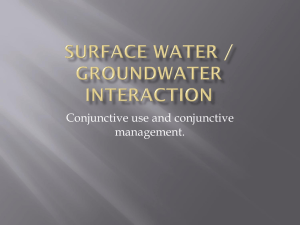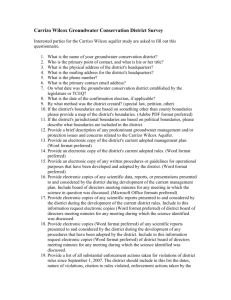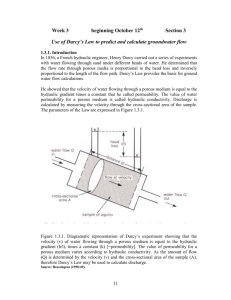Groundwater
advertisement

Groundwater Introduction • Definition—Water stored in the open space within rocks and sediments beneath the ground surface • Less than 1% of the water on Earth is stored as groundwater • Groundwater represents about 22% of the world’s supply of fresh water – 40 times the water in lakes and rivers – 1/3 of the world’s glacial and polar ice Depth of Groundwater • Most groundwater originates as rain water that percolates into the ground • Most occurs at depths less than 750 meters – The amount of groundwater would cover all the land areas to a depth of 55 meters – Water is found deeper, but the pressures are so great that the pore spaces are very small – Amount decreases downward at irregular rates Basic Terms • Porosity—the percentage of open space called pores • Permeability—how easily fluids can pass through a solid • Aquifer—“water-bearer” or a material water can move through easily – Must be both porous and permeable • Aquiclude—material through which water moves very poorly Basic Terms • Water Table – Separates the zone of aeration from the zone of saturation – Tends to be parallel to the land surface but to have less relief • Rises under hills • Descends under valleys – Rises in wet seasons and falls in dry seasons Basic Terms • Zone of saturation—all of the open space is filled with water • Zone of aeration – Belt of soil moisture—individual soil particles are coated with a thin film of water – Intermediate belt—drier, with some soil particles lacking water coating – Capillary fringe—immediately above the water table where water is drawn upward by capillary action Movement of Groundwater • In the zone of aeration, water tends to percolate downward under the influence of gravity – Its flow is impeded by clay particles to which it adheres – Its flow can be blocked by particles closing off pore space • In the zone of saturation, water migrates from where the water table is high to where it is lower Movement of Groundwater • • • • Velocity (V) is proportional to the hydraulic gradient V (h1-h2)/l The proportionality constant is K, which is known as the coefficient of permeability or the hydraulic conductivity Thus, V = K(h1-h2)/l Discharge is Velocity x Area so Darcy’s Law is Q = AV = AK (h1-h2)/l Wells Cone of Depression • Water table is depressed in area where pumping occurs • Size of cone of depression depends on rate of pumping and the permeability of the material Productive & Unproductive Wells Springs • Springs develop whenever the water table intersects the ground surface – This doesn’t happen everywhere because the water table tends to be parallel to the ground surface – It does happen when the ground surface is over-steepened, such as at fault scarps – It happens when fractures intersect the water table at a higher elevation than they intersect the ground surface – It also happens when rainwater is stopped in its downward percolation Springs Aquifers • An aquifer bounded by aquicludes is referred to as a confined aquifer • An aquifer not overlain by an aquiclude is an unconfined aquifer • Shallow, surface aquifers tend to be unconfined – The Cohansey aquifer locally – These tend to be easy to contaminate • Deeper aquifers tend to be confined – They are more likely to be bounded by impermeable layers – The are more difficult to contaminate – They may produce artesian conditions The High Plains Aquifer— An Unconfined Aquifer The Dakota Aquifer System— A Confined Aquifer Artesian Conditions Caves • Water moving along fractures dissolves limestone – Acids accelerate dissolution of limestone – Water and carbon dioxide produce carbonic acid – Other acids could also work • As fractures widen, underground open space develops – At what depth this happens is of some debate – Your book argues that caves form in the upper part of the zone of saturation Caves • Deposition of the cave formations – Must happen when the cave is above the water table – Your book says most formations develop while a stream is still flowing through the cave • Formations – – – – Stalactite—hangs tight from the ceiling Stalagmite—grows mighty-big from the ground Column—joined stalagmites and stalactites Drapery—sheets of dripstone Cave Formation • Water seeps into sinkholes and flows along fractures dissolving limestone Cave Formation • Erosion of stream causes general water table to drop, drying out some fractures Cave Formation • Cave forms above local water table, due to water from above seeping in through fractures Cave Formations Dripstone Drapery Flowstone Soda Straws Karst Formation • In areas underlain by limestone the surface is shaped by solution features – Streams disappear underground through fractures and reappear far away – Caves collapse producing sinkholes Karst Features Water Hardness • Water hardness is determined by the cations in solution – Divalent cations, such as Ca, Fe, Mg make water hard – Monovalent cations, such as Na and K make water soft • Hard water problems – Poor sudsing of detergents – Scale in pipes – Scale on surfaces Groundwater Temperatures • Groundwater is warmer in warm climates and cooler in cold climates • At depths of approximately 50 feet groundwater is about 50° F year round • As you go deeper than 50 feet, temperature increases 1°F for every 50 to 75 feet • Water from significant depth reaches springs at elevated temperatures Geysers • Rain water enters fractures in rock • Proximity to hot, igneous rock provides heat to warm groundwater • The pressure of the overlying water raises boiling point Geysers • When water begins to boil, some sloshes out lowering pressure • Water is now above its boiling point and flashes into steam • This causes a geyser eruption Groundwater Problems • • • • • Saltwater Intrusion Land Subsidence Septic Systems Contamination of Groundwater Contamination of Surface Water Saltwater Intrusion • An issue in coastal areas • Freshwater lens sits on top of salt water because it is less dense • Excessive pumping expands the cone of depression and causes saltwater intrusion • The freshwater lens can also be contaminated by pollutants leaking down from the surface Land Subsidence • Withdrawal of groundwater can cause the land to subside – Pore water occupies the space between grains and helps support the weight of overlying layers – Withdrawal removes this support causing subsidence Septic Systems • Septic systems are a way of handling human waste • Components – Septic tank in which solids sit and decompose • Tank must be large enough to allow solids time to decompose • Bacteria must be active to decompose solids – Leach field—liquid from the tank flows out to the leach field and percolates downward • By the time the effluent has reached the water table, it is clean Septic Tanks • Septic tank stores sewage allowing time for solids to be decomposed by bacteria • Liquids flow out into leach field • Liquids seep through permeable material and are filtered clean before they reach water table Septic Problems • The tank is too small so waste does not have time to decompose • The bacteria in the tank have been killed off • The material in the leach field is to permeable and dirty water reaches the water table • The material in the leach field is too impermeable, and the syustem backs up • The tank is too close to a well • Pressure-dose system to combat some problems








